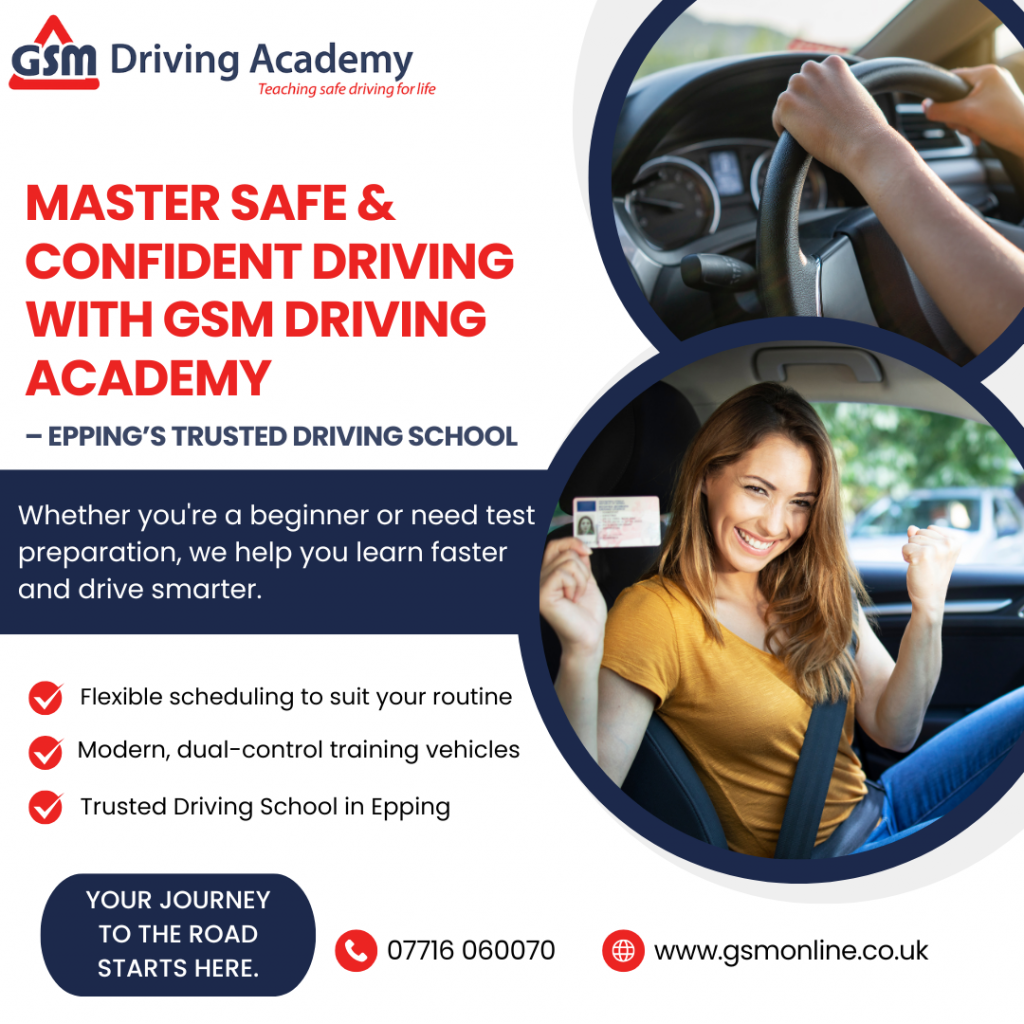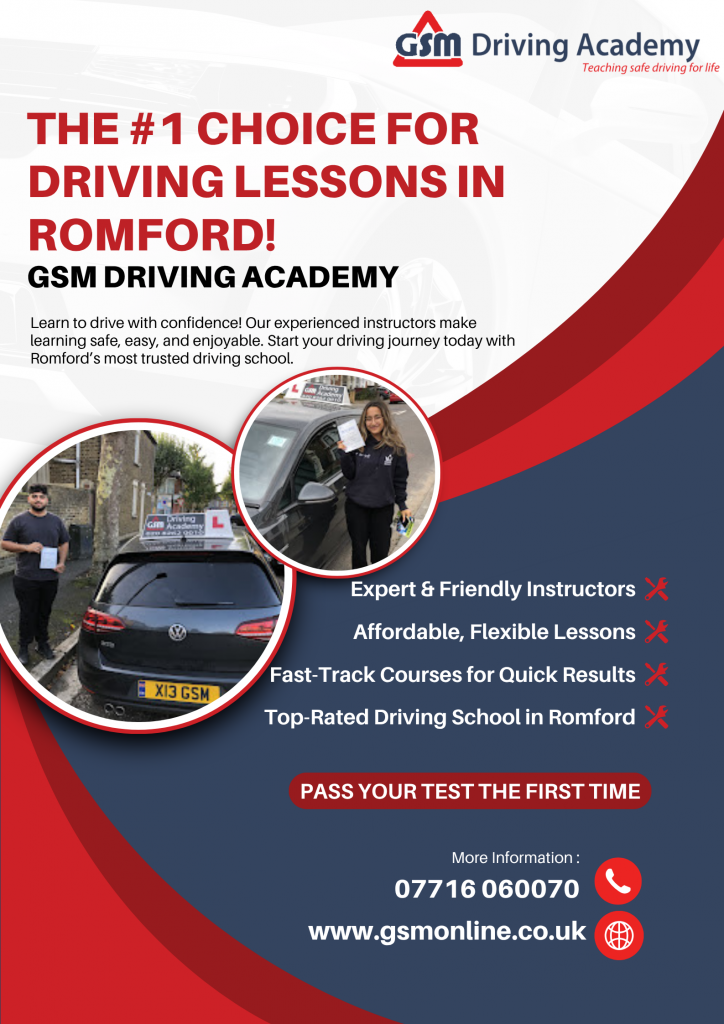Getting your driver’s license is a big step toward being independent, confident, and having more options. GSM Driving Academy is the best place to go if you want the best driving lessons in Loughton or if you want to learn from friendly, professional, and experienced instructors.
GSM Driving Academy has a great reputation in the UK for providing high-quality training. It is still a trusted name for new drivers, nervous drivers, and people who want to pass their driving test quickly and safely.
Why Loughton Students Choose GSM Driving Academy
Loughton is a busy town with many residential streets, high streets, and roundabouts. This makes it a wonderful place to teach new drivers. But picking the right driving school is the most important thing.
This is what makes GSM Driving Academy stand out from other driving schools in Loughton, UK:
Driving instructors approved by the DVSA
All of the teachers at GSM are fully qualified, have a lot of experience, and have been trained to teach lessons that are right for you.
100% Focused on the Learner
We tailor each lesson to your needs, whether you’re a slow learner or just need a little extra help.
Great Pass Rate for First Time
Structured training that happens regularly makes sure that a lot of GSM students pass their test on the first try.
Lessons on how to drive by hand and by automatic
Pick the transmission that works best for how you learn.
Trainers who are friendly and helpful
Our teachers make the classroom a safe place for nervous or anxious drivers.
Scheduling that works for you
You can choose from morning, evening, and weekend slots that work for you.
What Makes GSM Driving Academy the Top Choice in Loughton?
Customized driving lessons for each student GSM offers:
- Lessons for new drivers
- Driving lessons to refresh your memory
- Lessons on the highway
- Sessions to build confidence
- Driving tests that are fake
- Intensive and fast-track courses
This makes sure that each student meets the necessary driving standards at their own pace.
Full training on all of the Loughton test routes
Loughton has hard test routes, such as:
- Roundabouts that are busy
- Areas where cars can park
- A121, A1168, and A104 are all dual carriageways.
- Turns in residential areas and narrow roads
GSM teachers know these routes inside and out, and they get students ready for the test by putting them in real-life situations. This approach boosts students’ confidence and prepares them for the test.
Prices that are clear and fair
Driving lessons in Loughton can cost a lot, but GSM has cheap packages with no extra fees. We give:
- Options for pay-as-you-go
- Discounts for block bookings
- Special deals for people who are new
- Offers for intensive courses
You get the best deal without giving up quality.
Benefits of Choosing GSM for Driving Lessons in Loughton
Boost Confidence & Remove Driving Fear
Many learners fear roundabouts, hill starts, or narrow roads. GSM instructors use calm teaching methods to remove anxiety.
Learn Safe & Responsible Driving
Lessons cover defensive driving, speed awareness, hazard perception, and essential safety skills.
Learn at Your Own Pace
Every learner progresses differently. We adapt lessons to what suits you best.
Higher Chances of Passing Your Driving Test
With structured lessons and mock tests, your test day feels easy—not stressful.
Drive With Confidence on UK Roads
From city roads to motorways, we prepare you for all types of driving environments.
How GSM Driving Lessons Work
Step 1 — Book Your First Lesson
Simply contact us through our website or email. Choose manual or automatic.
Step 2 — Meet Your Instructor
A friendly, qualified instructor evaluates your starting level and sets a learning plan.
Step 3 — Lesson After Lesson Improvement
You will learn controls, manoeuvres, roundabouts, junctions, dual carriageways, parking, and much more.
Step 4 — Mock Tests & Final Preparation
We conduct practice tests to prepare you for the real DVSA driving exam.
Step 5 — Pass With Confidence
Once you’re test-ready, we help you book and pass your driving test.
What Learners Are Saying — Real Review on Google
Bis Bhadmus, Loughton
“Tabib was a really good Instructor and believed in me. I’m happy I’ve passed now, I’ll be back for refresher lessons!.”
Oluseun Adebayo
“Passed my driving test with Tabib, he is an excellent instructor, he his very clear, precise and detailed with the training and instructions. Really helpful and he his highly recommended. Thank you Tabib, thank you GSM driving.”
Why GSM Driving Academy Is the Best Driving School in Loughton
- Top-rated instructors
- Focus on safety and confidence
- Tailored training approach
- Excellent pass rate
- Local area knowledge
- Competitive pricing
- Positive student reviews
- Flexible lesson timings
When you combine all these factors, GSM clearly becomes the top choice for Driving Lessons in Loughton.
Frequently Asked Questions (FAQs)
Q1. How many driving lessons do I need to pass?
Most learners need 20–40 hours, but it depends on your pace and experience. We create a customised plan for you.
Q2. Do you offer automatic driving lessons?
Yes! GSM provides both manual and automatic lessons in Loughton.
Q3. Are your instructors DVSA-approved?
Absolutely. All GSM instructors are fully qualified and approved by the DVSA.
Q4. Do you provide mock driving tests?
Yes, mock tests are part of our structured training program.
Q5. How do I book lessons?
You can book via our website gsmonline.co.uk or email us at info@gsmonline.co.uk
Call to Action — Start Your Driving Journey Today!
Ready to become a confident and safe driver?
Let GSM Driving Academy guide you with expert training and friendly support.
📍 Location: Loughton & surrounding areas
🌐 Website: https://gsmonline.co.uk
📧 Email: info@gsmonline.co.uk
👉 Book your first driving lesson today and take the first step toward passing your driving test with confidence!



